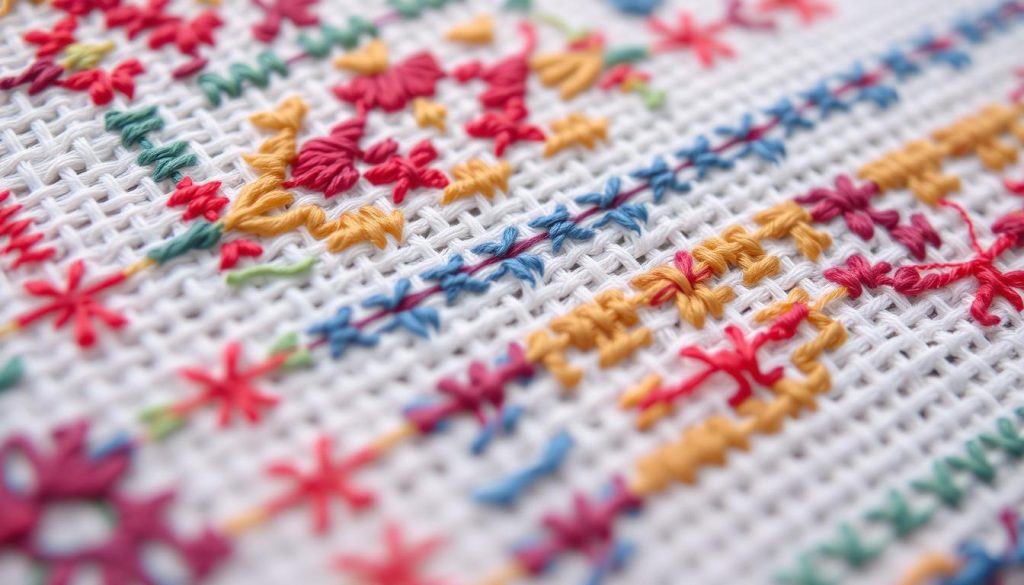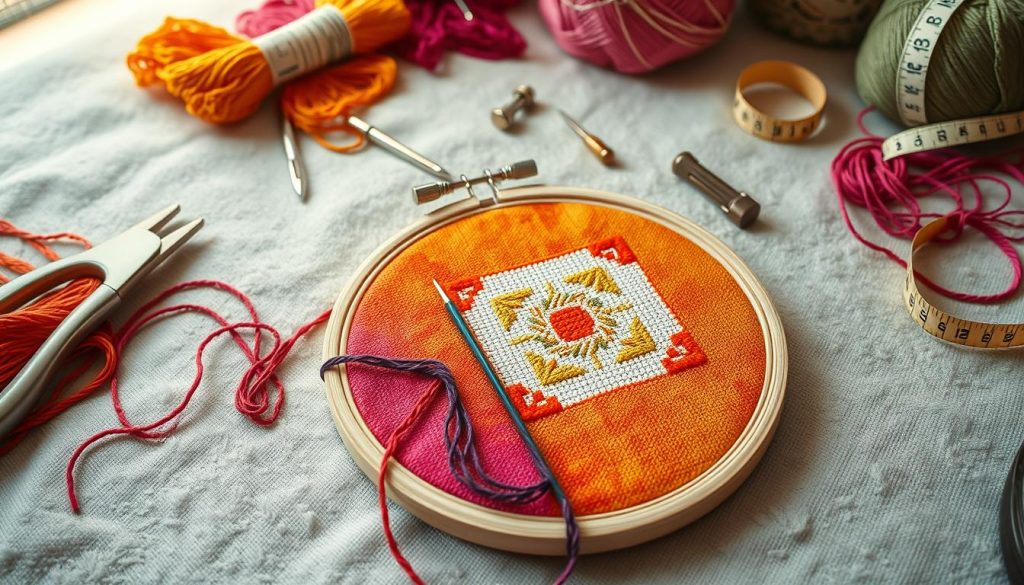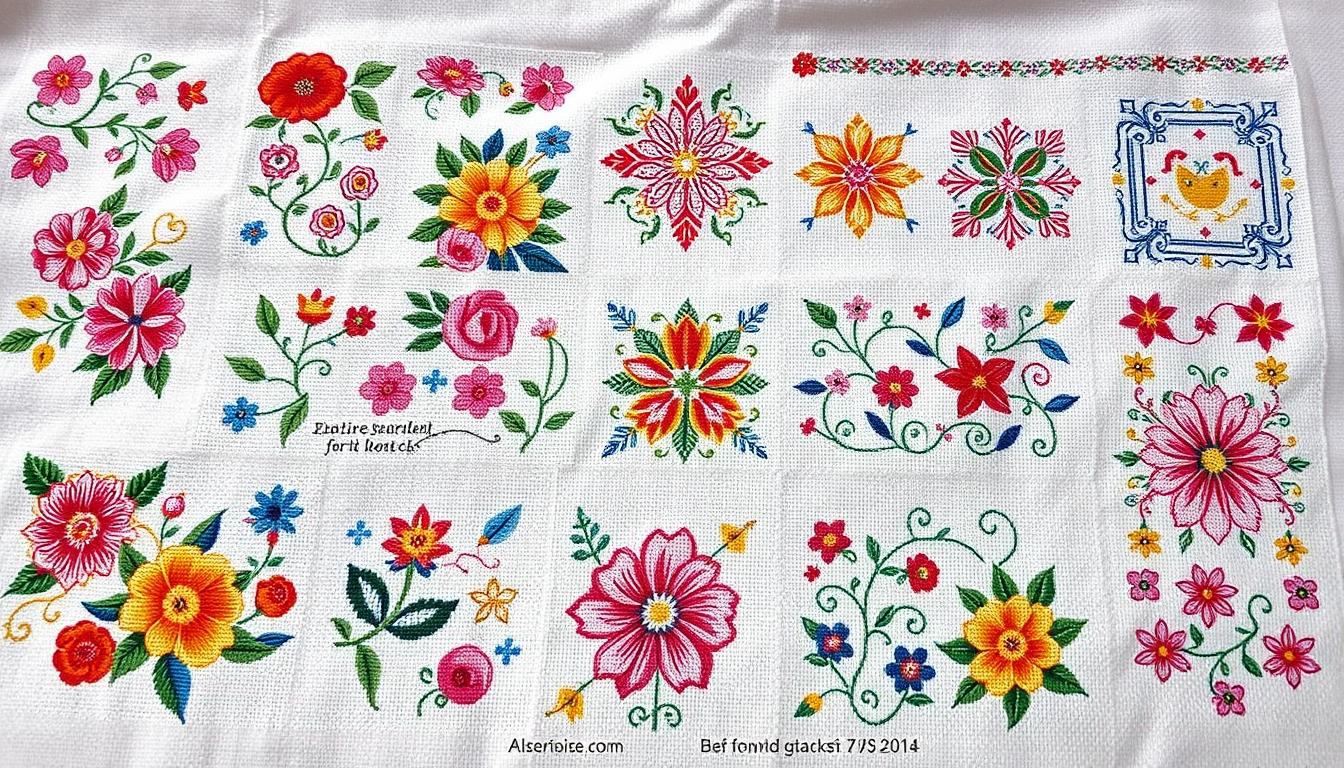When you start with cross stitch patterns, you might wonder about using 2 or 3 strands of floss. This choice affects your project’s look, feel, and how it covers the fabric. It’s important to think about the fabric and what you want your project to look like.
For light fabrics, 2 strands on a 14 count or 16 count fabric works well, say many experts. But, dark fabrics might need 3 strands for better color and coverage. Don’t be afraid to try different strands, whether you’re new to cross stitch charts or have been stitching for a while.
Key Takeaways
- Using 2 strands generally offers good coverage on light fabrics, especially for higher count fabrics like 16 and 18.
- For dark fabrics, 3 strands can enhance the stitch definition and visibility.
- The majority of cross stitch kits recommend 2 strands for 14 count fabric.
- Experimenting with different strand counts can help achieve your desired texture and depth.
- Your personal preferences and the specific cross stitch designs should guide your final choice.
Understanding Cross Stitch Strands
Starting with cross stitch? Knowing about strands is key. Using 2 or 3 strands changes your design’s look and feel.
What Are Cross Stitch Strands?
Cross stitch strands are the threads that make up embroidery. They come in 6 thin strands. You can use them alone or together, based on your project’s needs.
The Role of Fabric in Choosing Strand Counts
The fabric you choose affects strand count. The fabric’s count, or holes per inch, guides strand choice. For denser fabrics, use fewer strands.
| Fabric Count | Recommended Strand Count | Effect |
|---|---|---|
| 11 count Aida | 3 strands | Bolder, fuller stitches |
| 14 count Aida | 2 strands | Moderate coverage and detail |
| 18 count Aida | 1-2 strands | Finer, more delicate details |
Pros and Cons of Using 2 Strands in Cross Stitch
Two strands offer a good balance. They’re popular for many projects. Here’s what you should know:
- Pros:
- They give a delicate look
- Great for small details
- Save money by using less thread
- Cons:
- May not cover well on all fabrics
- Stitches might look less bright
Pros and Cons of Using 3 Strands in Cross Stitch
Three strands give more coverage and bold stitches. But, they have their downsides:
- Pros:
- They cover well on fabric
- Stitches are more vibrant
- Make designs pop
- Cons:
- Can be too thick for small details
- Use more thread
- Thread might tangle more
Fabric Types and Recommended Strands
Choosing the right cross stitch fabric and the right number of strands is key. Each fabric type—Aida, Evenweave, and Linen—has its own look and feel. This affects how your stitches look and how many you can fit in a space.
Strand Count for Different Aida Fabric Counts
Aida fabric is a favorite for cross stitching, coming in counts like 11, 14, 16, 18, 20, and 22. The number of strands you use depends on the fabric’s count. For 14-count and 16-count Aida, two strands work well.
On coarser fabrics like 11-count Aida, you might need three strands. But for finer fabrics like 18 or 22-count Aida, one or two strands are best. This keeps your stitches flat and neat.

Using Strands on Evenweave and Linen
Evenweave and Linen fabrics feel and look different from Aida. Evenweave has counts from 25 to 40, and Linen ranges from 28-count to 36-count. The thread count per inch tells you how many strands to use.
For counts 25 to 32, one or two strands are usually best. Evenweave’s smooth surface is great for detailed designs. Linen adds a natural charm to your projects.
Adjustments for Light and Dark Fabrics
Working with light and dark fabrics requires strand count adjustments. Darker fabrics, like navy or black, might need more strands to cover well. Even with finer counts like 18-count Aida, more strands are needed to avoid fabric color showing through.
On lighter fabrics, fewer strands might be enough. But always stitch a sample in natural light first. This helps you see how the coverage will be before starting your project.
Here’s a quick reference table for recommended strand counts based on Aida fabric counts:
| Aida Count | Recommended Strands |
|---|---|
| 11-count | 3 strands |
| 14-count | 2 strands |
| 16-count | 2 strands |
| 18-count | 1-2 strands |
| 20-count | 1 strand |
| 22-count | 1 strand |
By choosing the right fabric and strand count, you can get precise stitches and vibrant designs. This is true for simple or complex patterns.
Impact on Cross Stitch Designs
The number of strands used in cross stitch greatly affects the design’s clarity. Whether you look at historical pieces or modern works, the strand count is key. It determines the final look of the design.
How Strands Affect Design Definition
Using fewer strands can highlight delicate details and color changes. This is perfect for intricate designs. On the other hand, more strands add texture and depth. They work well for bigger design elements.
Creating Texture and Depth with Strand Variations
Varying the number of strands can create different textures and depths. This technique is shown in many cross stitch books. It adds complexity and interest to the patterns.
Examples of Detailed Cross Stitch Designs
Historical cross stitch examples show the impact of strand variations. For example, Lord Libidan’s Star Trek Voyager and Enterprise designs. They use different strand counts to add depth and emphasis. This shows the detailed work that goes into each stitch.
Thread Brands and Their Coverage
Choosing the right thread brand is key for your cross stitch project. Different brands offer various qualities like range, availability, quality, and manufacturing. Knowing about popular brands helps you pick the best for your project.
Popular Cross Stitch Thread Brands
In cross stitch forums, DMC, Anchor, and Madeira are often talked about. DMC threads have 482 colors and are known for their quality. They cost about $0.56 USD at 123stitch.com.
Anchor threads have 460 colors, a bit different from DMC. They cost the same as DMC at $0.56 USD at 123stitch.com. This makes them a good choice for specific colors.
Madeira threads are known for being easy to store and color-fast. They are durable and vibrant, making them a favorite among stitchers.
Differences in Thread Coverage Among Brands
Thread coverage affects how your design looks and feels. Here’s a comparison of popular thread brands:
| Brand | Range | Availability | Quality | Manufacture | Price | Total |
|---|---|---|---|---|---|---|
| Royal Broiderie | 4/5 | 2/5 | 1/5 | 2/5 | 4/5 | 2.5/5 |
| Presenica Finca | 2/5 | 2/5 | 5/5 | 4/5 | 3/5 | 3.2/5 |
| Cosmo | 4/5 | 2/5 | 5/5 | 5/5 | 2/5 | 3.5/5 |
| Appletons | 4/5 | 2/5 | 3/5 | 5/5 | 3/5 | 3.5/5 |
| J&P Coats | 4/5 | 2/5 | 5/5 | 4/5 | 3/5 | 3.5/5 |
| Madeira | 4/5 | 4/5 | 5/5 | 5/5 | 4/5 | 4.5/5 |
| Anchor | 4/5 | 3/5 | 5/5 | 4/5 | 3/5 | 4/5 |
| Sullivans | 5/5 | 4/5 | 5/5 | 5/5 | 3/5 | 4.5/5 |
| CXC | 5/5 | 5/5 | 3/5 | 5/5 | 5/5 | 4.5/5 |
| DMC | 5/5 | 5/5 | 5/5 | 5/5 | 3/5 | 4.5/5 |
Each brand has its own strengths. For example, Sullivans scores 4.5/5 for its range and quality. Cosmo, on the other hand, scores 3.5/5 for quality and manufacture but is less available.
Joining cross stitch forums and blogs can give you real reviews. This helps you choose the best thread for your project.
Choosing the Right Strand Count for Your Project
Choosing the right strand count is key to getting the look you want in cross stitch. Using good cross stitch tips can really help. We’ll look at tips for beginners and advanced stitchers. We’ll also talk about how your personal taste and trying new things are important.
Beginner Cross Stitch Recommendations
For beginners, start with 2 strands on 14-count Aida fabric. Most stitchers, 78%, use two strands on this fabric for standard projects. It’s easy to handle and covers well.
Advanced Techniques Using Different Strands
More experienced stitchers can try different strand counts for new textures and designs. While 68% use 2 strands often, higher count fabrics need 1-2 strands. Using 3-4 strands makes focal points stand out, and 6 strands give a chunky look.
| Strand Count | Fabric Count | Technique |
|---|---|---|
| 1-2 strands | High count (22+) | Fine detailing |
| 2 strands | 14-count Aida | Standard coverage |
| 3-4 strands | 14-count and lower | Focal points, depth |
| 6 strands | Varied | Chunky, bold effect |
Personal Preferences and Experimentation
What you like to stitch with can really change your project. Some like the thick look of 3 strands, while others prefer the fine detail of 2 strands. Trying different counts helps you find what you like best.
Adjust your finishing techniques to match the texture and depth of your stitches.
Cross Stitch Strands and Fabric Compatibility
The right choice of cross stitch strands and fabric is key to a great project. The strand count for your DIY cross stitch can make or break your design. Let’s look at what affects this choice.

First, think about your fabric’s weave tightness. Aida fabric, popular for vintage cross stitch, comes in different counts. For finer designs, use 2 strands on 18-count Aida. For looser weaves like 14-count Aida, 3 strands are better to avoid sparse stitches.
With modern cross stitch on evenweave or linen, the fabric’s texture matters. Linen threads add a rustic look, great for vintage or country themes. But, they might need a strand count adjustment to avoid bulkiness.
The design’s color and complexity also play a part. More strands can make stitches stand out on dark fabrics. But, light fabrics might only need fewer strands. For detailed designs, finer threads like silk or cotton blends work best, offering sheen and texture.
| Thread Type | Description | Best Use |
|---|---|---|
| Stranded Cotton | Six loosely twisted strands | Versatile for various stitching styles |
| Metallic Threads | Made from polyester, nylon, or metals | Special effects in detailed designs |
| Silk Threads | Luxurious sheen, blends colors well | Subtle gradations and detailed stitches |
| Linen Threads | Slightly uneven textures | Adding depth in vintage designs |
| Rayon Threads | Vibrant luster but fragile | Eye-catching embellishments |
| Cotton Blends | Durable and soft, combines cotton with other fibers | Diverse applications in cross-stitching |
By carefully considering fabric type, weave tightness, and design elements, you can achieve a perfect balance. Whether it’s a vintage cross stitch or a modern cross stitch piece, the right strand count makes your stitches look great and hold up well.
Conclusion
Choosing between 2 or 3 strands in cross stitch depends on several things. These include the fabric type, the texture you want, and your personal taste. Experienced stitchers often pick 3 strands for fuller stitches, with 65% agreeing.
Beginners, on the other hand, tend to use 2 strands. They find it easier to handle and the stitches look neater, with 78% agreeing.
Cross stitching is a great way to be creative and express yourself. You can make gifts, home decor, or baby patterns. The number of strands you use can change how your project looks.
55% of winners in cross stitch competitions use 3 strands for detailed designs. But online, opinions are split. 53% prefer 3 strands for durability, while 47% like 2 strands for a lighter look.
It’s important to try different strand counts to find what works best for you. This way, you can create something truly unique. Remember, the right materials and techniques are key to making your ideas come to life.
